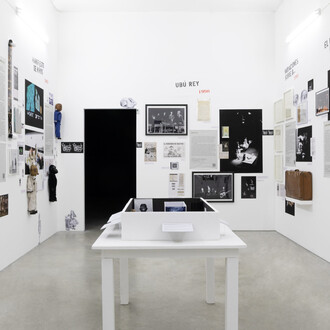‘Is this theatre?’ was a question asked by a press and public blinking in astonishment at the plays coming out of the Di Tella Institute’s Audiovisual Experimentation Centre (CEA) in the mid-1960s, led by theatre director Roberto Villanueva. That question mark was a banner under which a conservative tradition took a stand against the new artistic expressions. The CEA’s shows, happenings and ephemeral experiences invented new ways of doing theatre, unshackled by the prevailing realist plot of the time. The young ‘Di Tellians’ led a theatrical uprising which also engaged with dance and performance, pop theatre, the European neo-avant-garde and an unparalleled bodily freedom which opened up new political, artistic and vital horizons in answer to the repressive morality of General Juan Carlos Onganía’s dictatorship.
During the ’60s and ’70s, Tucuman-born director Víctor García burst onto the international scene with the same spirit of renewal and experimentation, while taking his ideas to a level of visual radicalism unimaginable for the theatre of the day. His work represented an unprecedented point of intersection between the visual and performing arts. This exhibition proudly brings to light the figure of Víctor García, Who, despite having marked a true watershed in contemporary theatrical history, remains a hidden character within the Argentinian theatrical field.
The journey establishes a bridge with another vital experimental space that emerged in Buenos Aires in the wake of the then recent return to democracy, in 1983: the Parakultural Centre. The Parakultural played host to a melange of theatre, rock and visual arts in which the body played a leading role, a wild party unleashed after the repressive terror of the last civil-military dictatorship (1976–83). These ‘parakultural’ experiences pushed the erasure of the boundaries between art and life to an extreme through the fervent practice of a kind of anti-theatre that set itself against the traditional modes of representation and circuits of production, against the text as a guarantor of meaning and, once more, against realism as the official aesthetic of Argentinian theatre.
While not claiming to be comprehensive, this historical exhibition focuses on eleven episodes that bring some of the avant-garde gestures of ’60s, ’70s and ’80s theatre closer to the Museo Moderno and our own contemporary moment. Eleven scenes from the Di Tella to the Parakultural; eleven sensitive geographies that forever expanded the terrain of Argentinian theatre and turned that initial question into a statement: ‘This is theatre’.





![Various artists, Tramoya [Stagecraft], exhibition view. Courtesy of Museo de Arte Moderno de Buenos Aires](http://media.meer.com/attachments/7b634d843c1effc76d8d97ac251e63a3ca21b283/store/fill/330/330/4e1ca5a8881d5780a8ebcddde81382609430ae6a59e4505a831583cc0ea1/Various-artists-Tramoya-Stagecraft-exhibition-view-Courtesy-of-Museo-de-Arte-Moderno-de-Buenos.jpg)










